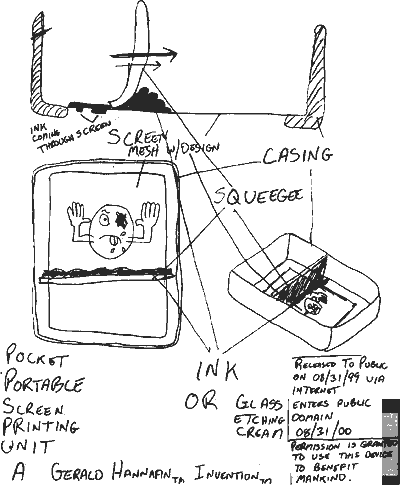
Below is the schematic for the newly designed Pocket Portable Screen Printing Unit, tentatively being referred to as the tagamatic.
Screen Printing Basics
Screen printing is depositing an image onto a surface by forcing ink through
a polyester screen. The image is fixed into the screen, which lets the ink through
in the right places to make a design. Very intricate designs can be reproduced,
on surfaces ranging from fabric to plastic to glass... the ink is forced through
the screen by pushing the ink across the screen with a squeegee... the squeegee
can be made of plastic, hard rubber, or aluminum. full tutorials on the screenprinting
process can be found at www.usscreen.com
...
The Tagamatic
The tagamatic is a small screenprinting system encased in a metal or plastic
container. Dimensions depend upon the size of the desired design. The open screen
area should be large enough to leave an inch of empty space between the design
and the edge of the box... With a 5"x7" container, two or three inches deep,
designs of postcard size 3"x5" may be reproduced. Unit will hold enough ink
to produce 20-50 prints before refilling, depending on image density and ink
viscosity.
A 7"x9" cake pan with a flat bottom is ideal... a 5"x7" rectangular hole is centered in the bottom of the pan... the screen should be mounted in a cardboard frame just small enough to fit snugly into the pan... the squeegee must be longer than the width of the design but short enough to fit inside the frame of the screen... the top can be sealed with two overlapping pieces of saran wrap, a la Kleenex box...
Ink
Ink used would depend on what surface is being printed on... there are some
good screenprinting inks, like the ones used to print bottles and cans, that
are just about impossible to remove without solvents... check Nazdar and Union
Ink for extended info...
Glass etching cream can be substituted for ink, for leaving behind permanent designs on glass (can only be removed by etching over or sandblasting- or replacing glass)
